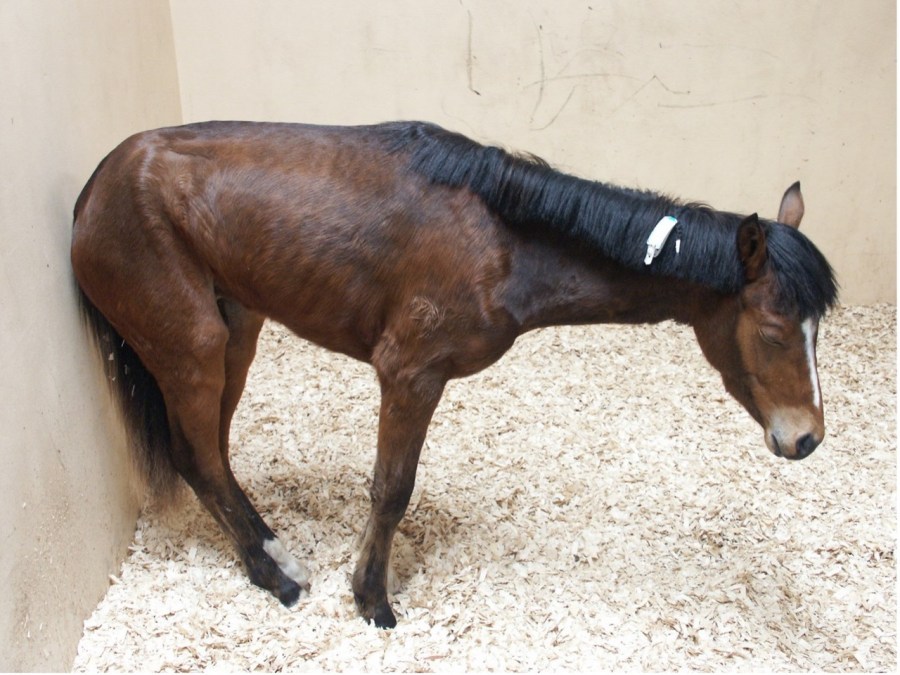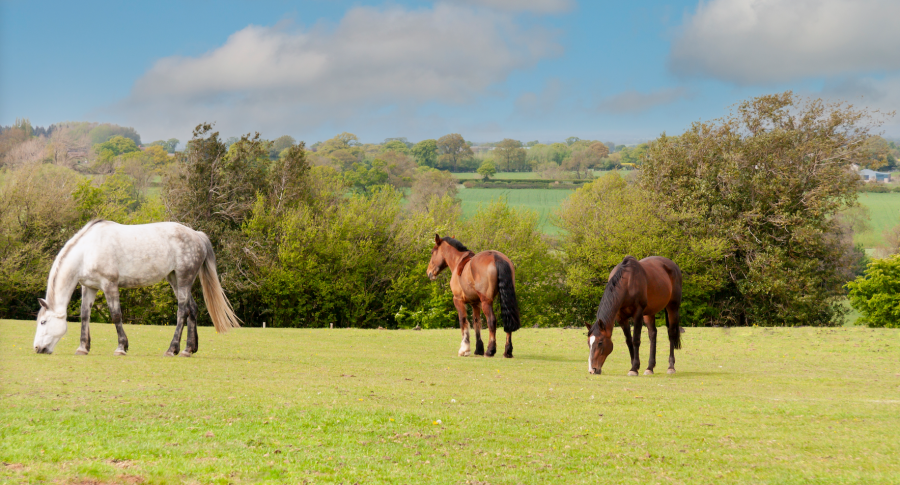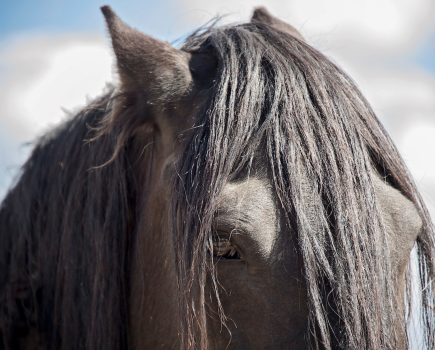Did you know that only 20% of horses who become unwell with equine grass sickness in the UK will survive? The rest will have to be humanely destroyed. Even those who live may need months of intensive nursing that can prove taxing and stressful for owners, such is its enormous impact on horse health.
According to Dr Beth Wells, a post-doctoral scientist leading the Equine Grass Sickness Fellowship Project, numbers of horses suffering with equine grass sickness peak in late spring, usually April, May and June, with a smaller peak in autumn. However, vets and researchers get cases reported all year round.
What is equine grass sickness?
Equine Grass Sickness (EGS) was first recognised in eastern Scotland in 1907. It is highly complex and involves damage to the horse’s autonomic nervous system, which functions unconsciously and regulates internal body functions such as gut peristalsis.
The latter moves the food along the gut during the digestive process. It is this gut function that is damaged in equine grass sickness, with a whole or partial gut paralysis resulting.
Previous research using pathology has identified that the damage caused during equine grass sickness is due to a neurotoxin, but there are more unknowns than knowns when it comes to this devastating disease.
Probable cause discovered
A major breakthrough occurred in 2024, when researchers found a probable cause for equine grass sickness: a neurotoxin produced by pasture microbes.
Experts have been searching for the cause of EGS for over 100 years and it is hoped that this discovery will enable scientists to develop new treatments and improve diagnostics for those horses suffering from the illness.
Researchers believe the cause of EGS is neurotoxic phospholipase A2, a toxin which is present in the venom of many poisonous snakes.
There is no suggestion that venomous snakes cause grass sickness, but it is hoped that some of the drugs used to treat and promote nerve regeneration in people who have been paralysed by snake venoms may be able to help horses recover from grass sickness.
Work is underway to definitively identify the source of this toxin. It is most likely to be produced by a microbe such as a bacterium or fungus growing on the horse’s pasture during the cold and dry weather, which commonly precedes the disease. Read the full research paper here.

Signs of equine grass sickness
- Horses suffering with equine grass sickness will often be dull and listless; one who is no longer first to the gate and who lacks interest in their food. They may chew that food, but not swallow it. The horse may also poo less than usual, or not at all.
- Putting an ear to the horses’ gut may reveal reduced or no gut sounds. This is a red flag, but it can also be caused by impaction, and so may be a sign of colic, which can confuse or delay diagnosis.
- Owners may notice muscle twitching and patchy sweating in some cases and the heart rate is generally very high. Ptosis of the eyelid, in which the eyelid droops, is another classic sign, but again this doesn’t occur in all cases.
Diagnosis
A definitive diagnosis of EGS can be made only by microscopic examination of nerve ganglia during a post-mortem, or by surgical removal (biopsy) of a piece of the ileum.
This is the final portion of the small intestine and the part of the gut that will display damage to or destruction of the neurons (the structural units of the nervous system) or ganglia (collections of nerve cell bodies).
These nerves are involved in peristalsis, and so once they are damaged or destroyed the gut becomes sluggish, impacted or stationary so that digestion is impaired and the stomach contents, with nowhere to go, may reflux down the nose — certainly not a normal process in a horse and a warning that something is badly wrong.
However, not all horses will present with all these symptoms and there are different types of the disease:
- Chronic cases may be mild to moderate and with the correct care around half of horses eventually recover.
- Sub-acute cases will be moderately severe, but as with acute cases the horse will need to be euthanised on humane grounds.
- Acute cases have severe and sudden onset of equine grass sickness and the horse will not survive, so in these cases euthanasia is the kindest option.
Environmental triggers
Scientists know that equine grass sickness is caused by a neurotoxin that is either ingested or kick-started by environmental factors in a horse who is already susceptible. The environmental factors of interest include the weather, soil and pasture.
The weather
Evidence is being accumulated through case reports that high-pressure weather systems that sit over a certain area for a specific length of time and which bring dry, hot, sunny days and near freezing/cool frosty nights (ie, large temperature ranges) could be a high risk factor.
These weather patterns tend to be more prevalent in peak equine grass sickness season.
Researchers have been working on a climate model using case location information and data from local weather sources and the Met Office. When completed, there will be a predictive model that should allow owners to be able to make management decisions based on fact rather than anecdotal evidence.
Grazing
To date, it is less common to hear of cases reported on a hill with unimproved grazing, with the majority of reports coming from permanent grazing and improved pasture — that is, fields that have been seeded and fertilised.
Clover
Clover has been researched previously but is still an area of interest because it offers a high-protein diet, and because it produces its own nitrogen, it enriches pasture.
Soil
There is evidence that soil disturbance is often a feature of pastures where cases of equine grass sickness have occurred. This can be due to activities such as harrowing, mechanical dung lifting and building shelters, etc.
Susceptible horses
In a field full of horses only one may succumb to equine grass sickness, so there are horse factors involved in the disease and the following two factors are of particular interest to researchers:
1 The microbiome
Equine grass sickness is a dysbiosis, or imbalance, in the gut microbiome and so scientists are interested in investigating this. Changes that can affect the microbiome include sudden alterations to management, such as a change of feed, moving yards and/or fields, general stress, or a sudden flush of grass.
2 Immunity
The statistics point to equine grass sickness being more common in younger horses. The greatest number of cases occurs in two- to seven-year-olds, with a peak at three to four years old.
This suggests that the immune system is involved in disease risk, as young horses won’t have as mature an immune response as older animals.
An older horse will build up immunity if they remain in the same place for a period of time, but if they are moved to a new yard they may need to rebuild his.
All of this indicates that when two trigger factors are combined — such as a young horse being moved to a new area — then this animal should be considered high risk.
The official statistics say that 2% of the horse population is affected by equine grass sickness in ‘hot spot’ areas.
The Equine Grass Sickness Fund receives around 100-120 reports of cases in a year, but knows that there are many more, hence needing the horse-owning population to help by filling in the survey.
Treatment
There is no magic drug or miracle cure for equine grass sickness. Any chronic cases that survive — and around half do — do so following either care at vet hospitals (which is going to rack up large bills) or intensive nursing at home under the guidance of a vet.
Generally, these horses will have had a milder attack of equine grass sickness, won’t have stopped eating and passing droppings completely, and the vet and the owner will have discussed whether the long period of intensive and often difficult nursing, which may last weeks or even months, is achievable.
If the horse is being cared for at home, there are a number of steps relating to two particular areas that can be taken to aid their recovery:
Companionship
- The horse may be depressed and crave the contact of a human they know well. They won’t want to be left alone for long periods and if they are they have no encouragement to eat.
- Stable the horse next to a friendly companion, which may encourage appetite, and also try using stable toys.
- Groom the horse and gently massage them.
- If the horse is sweating excessively, sponge them off with warm water and consider covering them with a breathable rug.
Feeding
- Feeding is key, but the horse’s appetite may fluctuate even well into their recovery. A high-protein diet fed in small, frequent meals through the day and night is the ideal, but in reality they may go off soaked bucket feeds.
- In some cases, human food, such as breakfast cereal, have been used to stimulate appetite. Apple juice may be offered as a drink.
- The horse may eat solid feed better if it is fed by hand or from a raised bucket.
- Give the horse access to freshly picked grass, or graze them in hand. Try succulents, too, such as apples and carrots cut into small pieces or even liquidised.
- Offer the horse hay, but don’t be surprised if, during the first weeks of recovery, they don’t eat large quantities or even any at all.
Prognosis
The road to recovery for a horse who has had equine grass sickness is often far from smooth. It will need resilience from the owner as well as the horse to get through those first difficult weeks/months, especially when it can be difficult to see any signs of improvement.
Some horses recover well enough to go back to a fully functional life and can even return to competitive careers. However, every case is different and some may be susceptible to issues like impacted colic due to gut function.
How to avoid equine grass sickness
Even experts struggle to say whether it can be avoided, but there are certainly strategies that can be followed to reduce risk, such as:
- Avoid sudden changes in routine or feeding
- Where previous cases of equine grass sickness have occurred, minimise exposure to that pasture
- Try to minimise close grazing and poaching of fields
- Avoid over-use of ivermectin-based horse wormers
- If the horse has just moved yards/areas, part stable them for a while and make sure they have hay every day
- Don’t worm during/following a high-pressure weather system.
Outbreaks of EGS
There was an outbreak of equine grass sickness at Queen Elizabeth II’s Balmoral Stud in 2020, when five ponies died, which raised the profile of this killer disease but money to fund most research comes from fundraisers.
Funding for the Equine Grass Sickness Biobank has been provided by the British Horse Society.
The Biobank was set up in 2021 to collect equine tissue samples and contains internal samples from 65 horses, but more are needed for the research to continue.
It isn’t always possible to persuade owners to consent to an invasive procedure on their horses after death and the project team is now working to raise awareness and promote sample collection as a priority.









